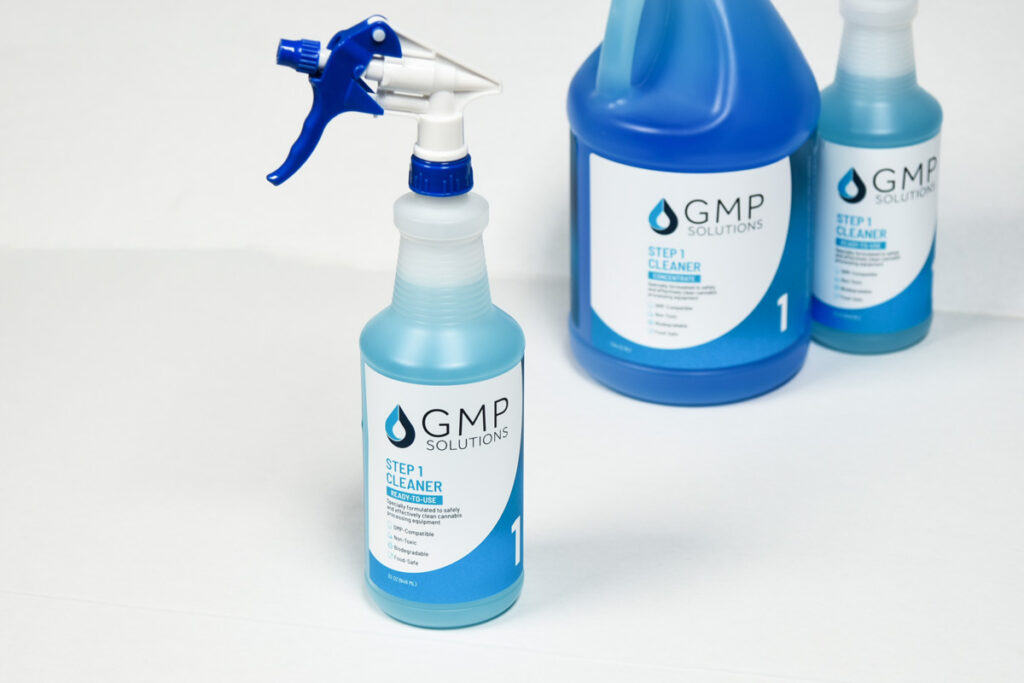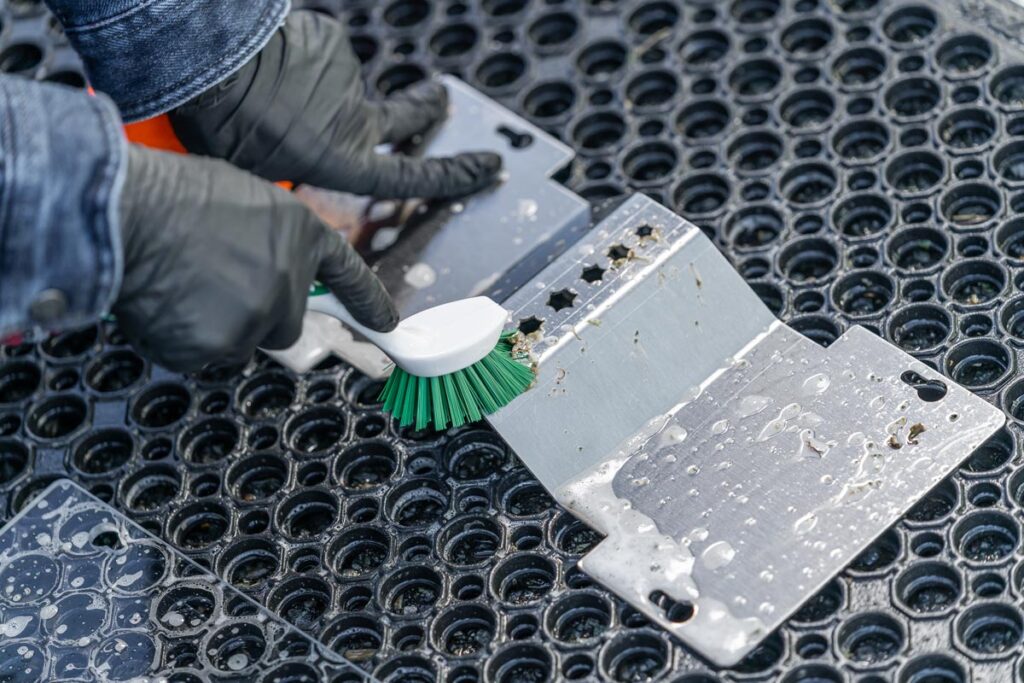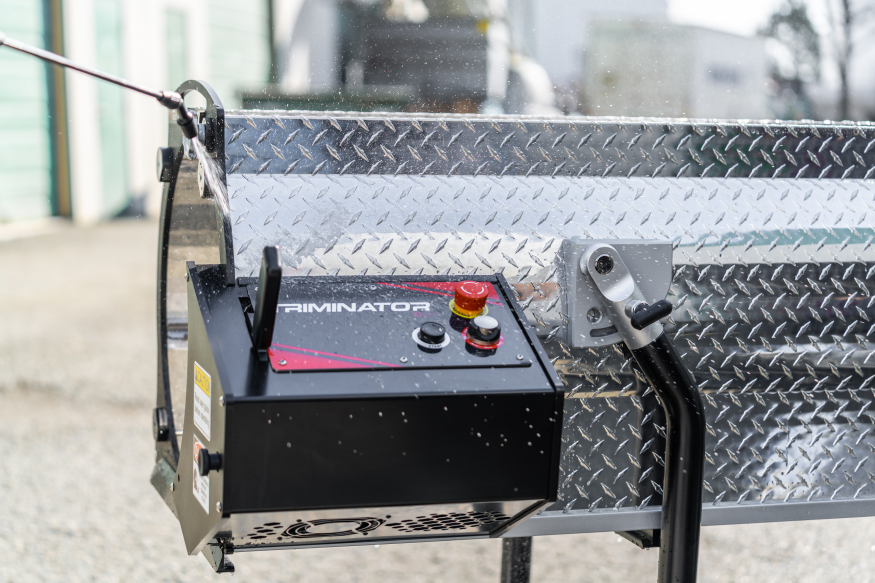What is a GMP cleaner, and why is it so important to cannabis cultivators?
In the rapidly growing cannabis industry, the focus on adherence to high-quality standards is increasing. As the industry expands and diversifies, and new players enter the market, compliance with regulations like Good Manufacturing Practices (GMP) is emerging as a crucial differentiator for cultivators.
GMP standards aren’t just important for ensuring products are produced consistently and meet stringent quality guidelines. They’re also critical to minimizing the risks to potential consumers. A GMP cleaner forms a part of a comprehensive strategy for GMP adherence.
Today, we’ll be exploring the world of GMP cleaning, and what cannabis growers need to know to pave the way for GMP certification.

What is GMP? Defining Good Manufacturing Practice
GMP or Good Manufacturing Practice, is a set of guidelines designed to ensure products are consistently produced and controlled according to strict quality standards. The GMP guidelines influence a wide range of companies and industries, from pharmaceuticals to the food and beverage sector, cosmetics, and now, the cannabis industry.
These guidelines provide a framework for maintaining the highest standards of quality in cannabis production, ensuring every step of the cultivation, harvesting, and processing journey is handled with care. Many jurisdictions worldwide apply GMP standards to cannabis production, meaning business leaders are carefully scrutinized for their approach to:
- Implementing rigorous quality management systems and standard operating procedures.
- Leveraging strategies to prioritize consumer safety, such as implementing measures to reduce the risk of contamination or the presence of harmful substances in products.
- Training employees on best practice guidelines, to ensure the production of consistently safe and high-quality products.
The enforcement and regulation of GMP standards are overseen by various organizations worldwide. For instance, the US Food and Drug Administration (FDA), promotes adherence to GMP standards within the United States. The World Health Organization (WHO), on the other hand, provides internationally recognized guidelines for GMP adherence.
GMP in the Cannabis Industry
The cannabis industry is undergoing a significant transformation, fueled by increasing legalization in various regions. So far, more than 40 countries have legalized cannabis for either medical or recreational use. This shift has led to the implementation of more stringent regulations aiming to ensure the quality, safety, and efficacy of cannabis products.
Implementing GMP regulation guidelines in cannabis cultivation, processing, and distribution delivers benefits in the form of:

- Product quality assurance: GMP guidelines provide a framework for ensuring companies maintain the highest standards of quality in cannabis production. They encourage companies to implement robust quality control measures throughout the entire production process, from cultivation to extraction and packaging.
- Consumer safety: GMP in cannabis production focuses on prioritizing customer safety. By adhering to strict standards, companies can reduce the risk of contamination, and harmful substances influencing their products. GMP emphasizes the use of safe production practices and rigorous testing for safety.
- Regulatory compliance: Many jurisdictions have now implemented regulations that companies need to follow in the cannabis industry. GMP serves as a guideline to help ensure compliance with these regulations, and cultivators can achieve GMP certification by closely adhering to the standards.
- Consistency and standardization: GMP practices promote consistency and standardization across the cannabis industry. With established operating and cleaning strategies, companies can ensure every batch produced is consistent in terms of potency and quality, ensuring consumers have a reliable experience with the brand.
Failure to adhere to GMP standards can have severe consequences for cannabis businesses. Issues can lead to product recalls, legal penalties, and damage to your brand’s reputation.
Critical Cannabis Operation Elements Encompassed by GMP
To understand the role of a GMP cleaner or GMP cleaning system in the cannabis industry, it’s important to look at all of the cannabis operation elements encompassed by GMP. The GMP standards encompass a wide range of operational elements, most of which have a connection with cleaning:
- Facility design and maintenance: The careful design and upkeep of a cannabis production facility are crucial to GMP compliance. Facilities need to be designed to prevent contamination and allow for easy cleaning and maintenance. GMP space and equipment cleaning protocols are essential to this.
- Staff training and competence: Well-trained and competent staff are essential for ensuring GMP standards are implemented correctly. Staff should be trained on contamination control procedures, which cleaning solutions to use, and when cleaning processes should be carried out in a GMP facility.
- Documenting SOPs: Standard Operating Procedures (SOPs) provide detailed instructions on how to perform operations safely, including cleaning processes. They can outline the core elements of each cleaning procedure in a cannabis facility, and help to promote consistency in staff activities and behaviors.
- Quality control and testing: Quality assurance or quality control measures including testing for contaminants and cleaning validation strategies are crucial in GMP. Maintaining a clean production environment, and testing for contaminants and disinfectant residues regularly is crucial to ensuring a safe product.
- Corrective and preventative actions: When deviations from GMP standards occur, corrective actions must be implemented to address the issue. Additionally, preventative measures should be in place to help reduce risk. Cleaning protocols are often enhanced and revised as part of these actions.
GMP Cleaning Requirements for Processing Cannabis

Ultimately, adhering to GMP guidelines in the cannabis industry demands a focus on the right GMP cleaning processes. Every aspect of a cannabis production and harvesting facility needs to be considered carefully, with GMP standards in mind, such as:
- The manufacturing facility: Facilities must be designed to minimize the risk of contamination and ensure easy cleaning and maintenance. This often means using equipment made with high-quality materials like stainless steel, which can be easily sanitized, and implementing proper ventilation methods to prevent contaminant build-up.
- Equipment: All equipment used in the production and post-harvesting process must be regularly cleaned and maintained to prevent the buildup of residues that could contaminate products. Equipment should be disassembled when necessary for thorough cleaning, and safe, effective cleaning solutions must be employed.
- Storage: Storage areas for finished products and raw materials must be kept in a clean, and orderly condition. This helps to reduce the risk of contamination or degradation of materials. Proper storage conditions need to be established and monitored, including implementing humidity and temperature controls.
- Product development: Cleanliness in product development areas is essential for preventing cross-contamination between different batches of products. This means companies must maintain clean workspaces, use dedicated equipment when required, and adhere to strict cleaning protocols between development activities.
Creating a Cleaning Validation Protocol for Your Operation
Whether you choose to hire expert GMP cleaner services to assist you in maintaining GMP standards, or you implement cleaning procedures yourself, it’s important to have the right cleaning validation protocol in place. This will include solutions like an equipment and machine cleaning SOP, which looks at things such as:

- Pre-cleaning assessment: Evaluate your equipment and the residue present to determine the most effective cleaning method and the ideal cleaning solution.
- Disassembly: Safely disassemble equipment to ensure a thorough cleaning process.
- Dry cleaning: Remove loose particles and residue with a cloth before applying any solutions.
- Wet cleaning: Use appropriate cleaning agents and water to remove residues completely.
- Rinsing: Rinse the equipment thoroughly to eliminate disinfectant residues.
- Sanitizing: Apply a sanitizing solution to eliminate microbial contamination.
- Drying: Ensure the equipment is completely dry before reassembly to prevent microbial growth and mold.
- Reassembly: Reassemble the equipment according to the manufacturer’s instructions.
- Verification: Validate the cleaning process through visual inspections, and consider microbiological swab testing when necessary.
Often, a cleaning service will be able to provide comprehensive guidance on which cleaning agents to use, which strategies to implement, and how to validate the efficacy of your cleaning procedure.
Ensure GMP Compliance Through Training and Audits
Ensuring compliance with GMP is an ongoing process, which requires a combination of effective employee training, and careful evaluation. To ensure you can achieve GMP certification, and meet the requirements set by these standards:
- Develop an employee training program. Create an ongoing training schedule for all employees, focusing on GMP principles relevant to their job functions and roles. Explore a range of training methods, such as workshops, and hands-on training, and regularly test employees’ knowledge and understanding of GMP guidelines.
- Schedule regular internal audits. At regular intervals, audit your processes and facilities to assess compliance with GMP standards. Develop a comprehensive checklist based on GMP guidelines that covers all areas of your operation, from material sourcing to final product distribution, and follow up on your findings.
- Implement corrective actions. Develop a corrective action plan for every non-compliance issue identified. Prioritize the steps you need to take based on the level of risk and monitor the implementation of new strategies and protocols.
Regular auditing and comprehensive training should help to minimize the risks of non-compliance when it comes to implementing GMP cleaning strategies.
Integration of GMP with Other Quality Management Systems
It’s also worth looking at how GMP guidelines integrate with the other quality management systems you already follow in your organization. While GMP standards focus primarily on manufacturing processes, ensuring products are consistently produced and controlled, ISO standards like ISO 9001 provide a broader framework for quality management in any organization.
Integrating your GMP policies, standard operating procedures, and validation methods with the guidelines you follow for ISO can lead to a more robust quality management strategy.
This type of quality management approach assists in establishing a comprehensive framework of standardized production, fostering continuous improvement and operational efficiency within your organization.
To develop an integrated policy, you’ll need to start by conducting a gap analysis, comparing your current quality processes with GMP and other relevant ISO standards. Then, develop an integrated and unified policy that incorporates the principles and requirements of GMP, ISO, and any other standards relevant to your organization.
Standardize the documentation you create, including SOPs, and implement a training program that guides employees through the process of remaining compliant with all regulatory guidelines.
The Importance of GMP-Level Cleaning
Ultimately, adherence to GMP standards relies heavily on your ability to employ the right GMP cleaner and implement the correct GMP cleaning procedures. In today’s world, the effective implementation of GMP isn’t just a regulatory requirement in many regions, it’s also a foundational element for ensuring product safety, quality, and consumer trust.

Following the guidance above as you implement the right cleaning procedures and strategies into your cannabis operation will help you elevate your business above the competition.
Additionally, using the right equipment in your business environment will make the cleaning and maintenance process much simpler. For instance, GMP cleaning solutions are GMP-standard certified, and made with high-quality stainless steel, for simple and effective cleaning.
Reach out to the GMP Solutions team today to learn how our cleaning solutions can help you adhere to GMP cleaning standards.